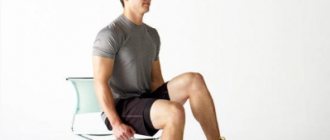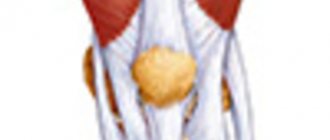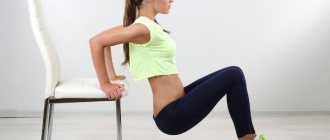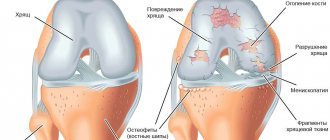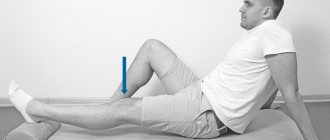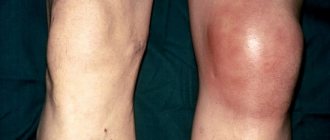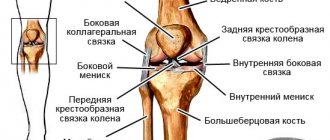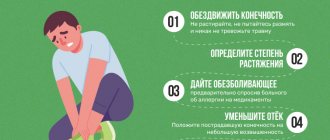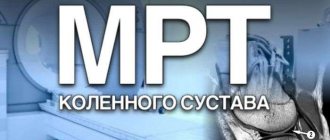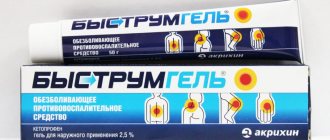Injuries to the medial ligament of the knee (medial collateral ligament) can vary greatly in both the type of injury and treatment. Regardless of whether you have had surgery or not, you will have to wear a brace or a plaster cast. And when it is removed, proper and, most importantly, effective rehabilitation will be necessary.
This exercise program will help you quickly relieve pain, strengthen muscles and restore mobility in your knee.
Clothes should be loose, it is advisable to remove shoes. Perform all exercises (especially the first days) smoothly and gradually. Remember the important principle: “Endure mild pain, do not allow severe pain.”
You can do the first 6 exercises right away. The rest only after your doctor allows axial loading.
Reverse leg tension
Lying on your stomach, legs straight, hands under your head. Pull in your stomach, tense and lift the leg you are working on 20 cm from the floor. Hold the straight leg in this position for 5 seconds, then relax and return the leg to the starting position. 2 sets of 15 reps.
Exercises with an expander
Attach one end of the expander to the ankle of your healthy leg, and the other end to a door or other stationary object at ankle level.
What exercises for the knee joints will help stretch the muscles?
When performing muscle stretching movements, monitor your sensations and take your time. You should experience only mild discomfort, but not pain. Do not try to increase your range of motion by jerking, as this may result in injury.
Hamstring stretch
Sit on the edge of a chair, leave your right leg bent, and straighten your left leg and place it on your heel. Turn your left toe slightly to the side. Keeping your back straight and your left thigh tight, lean your body forward.
Feel the stretch in the back of your straightened leg. Stay in this position for 15 seconds and then repeat on the other leg. Do 3 sets on each leg.
Iliotibial band stretch (ITT)
To stretch the PBT on the right side, cross your right leg behind your left and tilt your torso to the left, pushing your right hip out to the side. Lean to the side, not forward, and don't put your butt back. You should feel the outer right thigh stretch.
Hold this position for 15 seconds and repeat on the other side. Perform 3 sets on each leg.
Standing Anterior Thigh Stretch
While performing this movement, you can hold on to the back of the chair with one hand to avoid losing your balance. Bend one leg, grab your ankle with your hand and pull your heel toward your buttock. Feel the stretch in the front of your thigh.
To increase the stretch, tilt your pelvis back—imagine pulling your pubic bone toward your belly button. Hold the position for 5-10 seconds, then return your foot to the floor. Perform 5 times on each leg.
Butt stretch
Lie on your back, lift one knee and pull it closer to your chest, wrapping your arms around it. Point your knee toward the opposite shoulder, giving your gluteal muscles a good stretch.
Hold the position for 30 seconds, then lower your leg and repeat on the other side. Do 5 reps on each leg.
Standing calf stretch
Stand close to the wall, take a step back and bend your front leg, leaving the other straight. Lean your body forward, leaning against the wall. Feel the stretch in your calf muscles. Hold the position for 30 seconds, then switch legs and repeat the same. Do 5 times on each side.
Half squats with resistance
Stand facing the door. Fasten one end of the expander under the knee of the leg being worked out, and the other end to a door or other stationary object at the level of the knee joint. Raise your free leg off the floor; you can hold on to a chair or armchair for balance. Bend the knee you are working on slightly (do a half squat on one leg), then slowly straighten your leg. Repeat 15 times. You can simplify the exercise by not lifting your free leg.
How exercise can support knee health
First of all, the exercises are aimed at strengthening Knee exercises for runners the muscles that surround and support the knee joint.
Most of the recommended movements involve the quadriceps, three muscles in the back of the thigh, and the gluteus maximus and gluteus medius. The Lifehacker Telegram channel contains only the best texts about technology, relationships, sports, cinema and much more. Subscribe!
Our Pinterest contains only the best texts about relationships, sports, cinema, health and much more. Subscribe!
Also, physical exercise plays an important role in maintaining the volume of articular cartilage, the thinning of which is associated with a disease such as osteoarthritis Osteoarthritis. Scientists suggest The effect of physical activity on the knee joint: is it good or bad? that cartilage can increase in response to mechanical stress created during exercise.
This may be why knee exercises that develop muscle strength, coordination and balance help. Efficacy of strengthening or aerobic exercise on pain relief in people with knee osteoarthritis: a systematic review and meta‑analysis of randomized controlled trials, The Ottawa panel clinical practice guidelines for the management of knee osteoarthritis. Part two: strengthening exercise programs for people with osteoarthritis to relieve pain and improve quality of life.
In addition, for knee health (and pain relief from osteoarthritis), Knee exercises for runners, Knee Stretches are often recommended to perform not only strength movements, but also stretching exercises for the muscles of the thighs and lower legs. It can be assumed that such movements increase the mobility of the hip and ankle joints, which will improve the biomechanics of movements in sports and everyday life and relieve some of the load on the knee joints.
Wall Squats
Stand with your back to the wall, looking straight ahead. Feet shoulder-width apart and at a distance of 40-50 cm from the wall. Squat down slowly until your thighs are almost parallel to the floor. Hold this position for 10 seconds. Smoothly return to the starting position. 2 sets of 15 reps. Gradually increase the hold time to better strengthen the quadriceps muscle.
When should you strengthen your knees?
How the affected area should be strengthened largely depends on the root cause of the resulting damage to the knee joint and ligament. First of all, strengthening exercises should be performed by those who have a weak musculoskeletal system and ligamentous system, in which the following diseases often occur:
- tendency to bone fractures;
- the occurrence of sprains and tendon ruptures;
- manifestation of bursitis, presence of arthritis;
- the occurrence of damage in the meniscus area;
- difficulties in the functioning of the knee joint.
Doctors recommend carrying out strengthening joint therapy at certain periods related to the degree of the disease and its manifestation:
- rehabilitation of the knee after removal of the plaster cast;
- for arthrosis, bursitis and arthritis during inflammatory processes;
- during the recovery period after injury or dislocation;
- with changes in weight and obesity;
- with significant physical stress on the knee joint, as well as pain that occurs when bending and straightening the knee;
- if there is no natural tension in the knee area;
- during the rehabilitation period associated with knee replacement.
It is worth adding that in order for strengthening exercises to have a greater effect, they should be combined with correction of eating behavior and lifestyle in general, for this you should definitely consult your doctor.
Platform rotation
- Rotate the balancing platform clockwise until its edge is in constant contact with the floor , then counterclockwise. Repeat 30 times in each direction.
- Rotate the balancing platform clockwise until its edge touches the floor , then counterclockwise. Repeat 30 times in each direction.
Restoration of knees according to Bubnovsky
Doctor of Medical Sciences, famous doctor and author of many books - Sergei Mikhailovich Bubnovsky offers his own set of exercises to help restore knees. The basis of the Bubnovsky complex is the process of activating blood supply and simultaneous strengthening of the spine, as a result of which it becomes possible to reduce the pressure of body weight on the legs and specifically the joints and knees.
Daily classes using the Bubnovsky system allow you to:
- reduce pain;
- increase mobility;
- stabilize fluid production inside the joint;
- strengthen the muscles and ligaments responsible for the functioning of the knee.
The most important thing is the simplicity of the exercises and, accordingly, their accessibility for everyone, so the effectiveness of recovery training begins soon.
The main exercises of the complex consist of:
- in raising the leg from a lying position with fixation and bending it at the knee, while the other leg should remain motionless.
- in bringing the knee to the tip of the nose, performed from a lying position and with the legs brought together.
Avoid harmful movements
Avoid movements that put too much stress on the hamstrings. Steep inclines cause you to lift your legs and bend over when you run, hike, or walk—this is quite normal when your hamstrings are strong and can handle the load, but if they are weak or already overextended, you are at risk for serious injury or recurrence. If you activate your hamstrings and start to experience pain in them, reduce the load or avoid that particular movement altogether. If hamstring injuries begin to plague you frequently, consult a qualified trainer or physician for a biomechanical analysis.
Warm-up
Before your workout, do a dynamic hamstring warm-up. "There are 5,000 ways to warm up your hamstrings—it's just a matter of using different types of movements similar to the ones you're going to do," Haas says. For example, if you're going to climb rocks, use a box, bench, or boulder to simulate steps and ledges to gently activate your hamstrings.
Dynamic Hamstring Mobilization - Swing your leg back and forth while holding onto a stationary object. A good way to warm up your hamstrings before hiking, running, biking, skiing or climbing. When moving your legs, be careful if you are going to twist your back while trying to touch your toes, as this will tighten other muscles, taking the emphasis off the hamstrings.
Physiotherapeutic procedures
Photo from the site ponchikov.net
Methods of physiotherapeutic development of the knee joint are considered to be auxiliary means of recovery. Treatment is prescribed at an early stage of rehabilitation, when it is necessary to relieve pain after a fracture and prepare the limb for development. For this purpose, they most often use:
- electrophoresis with anesthetics;
- magnetic therapy;
- UHF;
- laser therapy.
Applications with paraffin or ozokerite will help to develop the knee and quickly cope with swelling. The procedure moderately warms the deep tissues, helping to dilate blood vessels and reduce pain. As a result, nutrition of the injured area is improved and healing is accelerated.
Ailments after injury
For sprains or rehabilitation after surgery or illness, gentle physical therapy is required. In addition, the injured limb should be fitted with a brace or knee brace to prevent joint damage, instability, or recurrence of joint disease. For example, after partial damage to the ligaments, if there is no additional support in the form of a bandage, there is a high probability of their rupture.
Exercise therapy must be carried out together with a specialist; usually, first, all actions are carried out on the bed and they all come down to raising the limbs and holding them, then there are slight bends. Further exercise therapy can be complicated.
Massage
Massage will help to develop your knee faster after a fracture and removal of the plaster. It is prescribed from the second week, 1 time per day. The procedure activates blood flow, relaxes and restores elasticity to muscles, warms up ligaments, eliminates swelling and pain.
It is better if the massage is performed by an experienced specialist. But if you don’t have one or if other difficulties arise, you can do the massage yourself. All movements should be performed gently and carefully, moving from bottom to top.
The procedure begins by stroking the ankle. Then it is kneaded and raised along the calf muscle to the knee. Do not press or rub the cup or bone tissue. It is necessary to act only on the periarticular ligaments and move along the thigh to the groin.
